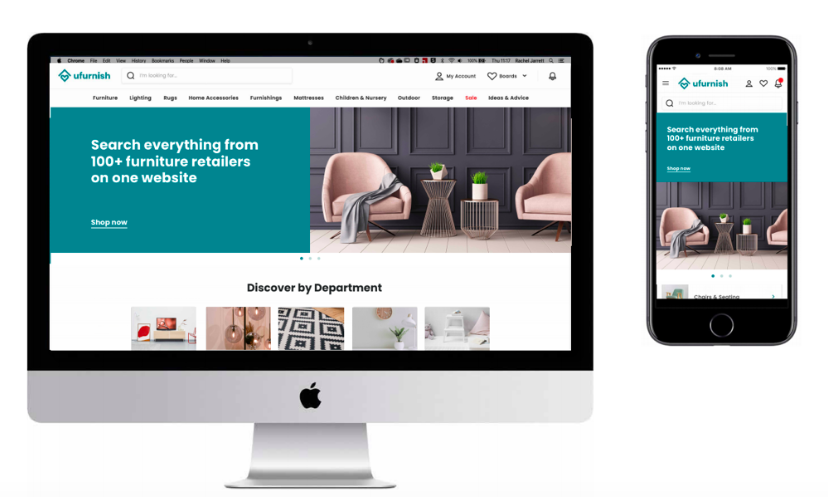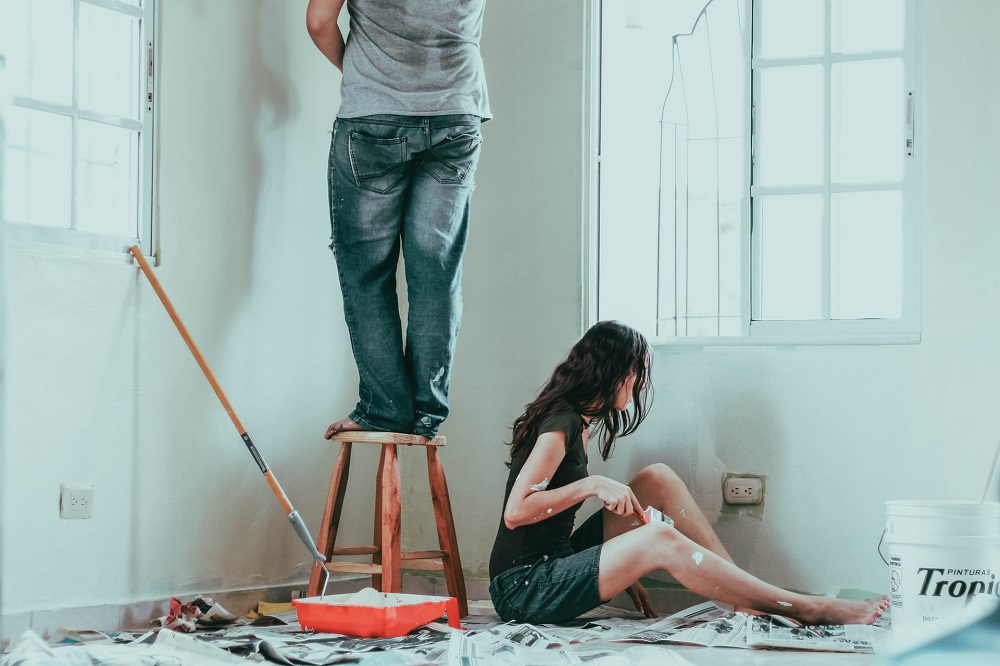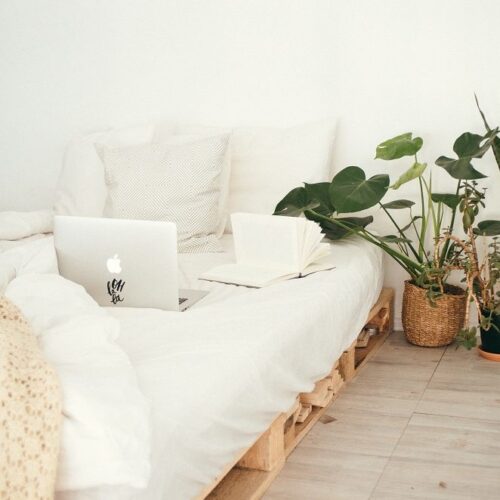Ad – Promotional post in partnership with ufurnish.com

Are you thinking of decorating or updating a room in your home? Although exciting, it can be quite daunting too. Where do you find your inspiration? How do you choose the perfect colour scheme, furniture, layout and accessories? Tying everything together in a cohesive way, whilst sticking to a budget and timescale requires skill, which is why people often feel out of their depth and would rather call on the expertise of an interior designer. That’s fine of course and there are some fantastic home design services out there to help you realise the room of your dreams. Alternatively, you may fancy having a go at doing it yourself and – with a little confidence and the right tools of the trade – becoming your very own interior designer is not out of reach. Here’s how to go about it:
Get Inspired
Inspiration is all around us. You could buy or borrow some interior design magazines and hop onto Pinterest and Instagram to save the pins and images that appeal to you. Spend some time doing this and analyse the elements of a room that you find attractive. Is it a pared back, neutral look that you’re drawn to, or a colourful and eclectic interior? Vintage or contemporary? Dark or light interiors? What kind of decorative elements appeal to you, is it lots of plants or a tribal rug? Do you need new furniture such as a sofa, coffee table or sideboard? Curtains or blinds? Do you need extra storage or lighting? List the elements you definitely want to include in the room as well as the decorative finishing touches you’d like. Maybe there are items in other rooms you want to swap or upcycle as part of your design.
Choose Your Base Colour

The four walls are the biggest area in any room, followed by the floor and what is sometimes referred to as the fifth wall, the ceiling. So the base colour in these elements is an important factor and you need to think about whether you want a dark and cosy base or something lighter or more neutral. What sort of flooring will convey the feel you are after – a textured carpet or a hard, smooth floor? Choosing paint for the walls and woodwork needs careful consideration and it’s essential to try testers in your room before committing to a colour, because a lot can depend on the room’s aspect and how much light flows in. Wall paint can alter throughout the day and under artificial light at night, so it is worth painting a few areas with your samples and observing how the tone changes and whether you like it!
You’ll also need an accent colour – a second colour or variation of your base that will appear in the room in smaller quantities, be it in your sofa, cushions, rug, wall decor etc. If you really haven’t a clue about colours, take a look at a colour wheel to see the relationship between contrasting or harmonious hues. It may also help to have a virtual chat with a professional, as I did recently for my hall makeover (coming to the blog soon). I consulted with an expert at the paint company, Lick Home.Com over a video colourist session to help me decide on a cohesive colour scheme and for me it was a great starting point for the rest of the design to follow.
Make a Mood Board

This is what all professional designers do before embarking on a project. It is impossible to keep every design idea in your head and visualise them fully, so create a mood board to plan your scheme and ensure it works. Mood boards can be made collage style on a large piece of card with upholstery fabric and wallpaper samples stapled to it, alongside your base colour and accent colours in the form of paint swatches and accessories. Cut out and stick on pictures of furniture pieces and accessories such as lamps from magazines. Try include something in your design that will make a great focal point – a mirror or designer wallpaper or statement sofa, for example. You can also include abstract images such as a sea view or a field of corn, which may have inspired your initial thoughts for the room. It helps you to keep focused on the mood you’d like to convey in your space. Or you may prefer to make a virtual mood board by cutting and pasting images into an online tool, such as Canva which is a free, easy-to-use graphic design tool used by lots of designers.
- Register or log onto Canva
- Click create a design (top right)
- Select Mood Boards Photo Collage
- Pick a template and start uploading images you saved
The main advantage of a mood board is the ability to experiment and see which things work in harmony and excite you. For example, here’s a design I came up with for a Moroccan style garden room – this style could revamp any boring conservatory or sunroom. Simply decorate with authentic colours and update your conservatory furniture, add candles and lanterns, exotic plants and a ceiling fan in your design.

Use ufurnish.com
Take a tip from professional interior designers, who are often managing multiple projects and have to be efficient and mindful of budget constraints. They don’t have enough hours to be endlessly searching the internet for the right furniture and decorative accessories, or trawling around homeware stores and furniture departments on foot. They work smart by logging onto websites such as ufurnish.com which can do a lot of the legwork in a fraction of the time. It doesn’t cost anything to use ufurnish and you therefore need to bookmark it as your new go-to destination website when searching for home furniture and furnishings!

Having used ufurnish.com myself, I’ve discovered an amazingly wide choice of products from right across the retail market in the one place, so this powerful search engine is effectively reinventing the way we shop for our homes, allowing us to discover, compare and buy from a huge marketplace, all from the convenience of our living rooms.

I know that a stumbling block for many people choosing furnishings is a feeling of overwhelm. Or the fear of buying a sofa, then seeing a different one the following week which you prefer. We are bombarded with gorgeous home images on Pinterest, Instagram and in interior design magazines in a range of styles from Scandi and Boho to Industrial or Coastal. At the end of the day it’s your home and their are no hard and fast rules. Go with what you love and a gut feeling! And even though there are thousands of products on offer from hundreds of retailers at ufurnish.com, you can avoid that overwhelm, thanks to the intuitive functionality of the website. The easy to use filters ensure you can refine your requirements, ensuring a more tailored range of items are returned on a search, across a number of brands and appropriate to your budget. By being able to compare and save items, you can feel confident about your final choices. Then if you do decide you do want to purchase an item, you can complete the sale easily via the site as it seamlessly connects you to the retailer.

As a home interior design blogger, I am constantly checking out new collections and trends and it can be quite exhausting. That’s why the new ufurnish.com website is such a great concept. There’s a rich and eclectic mix of retailers already featured on the site and with more joining all the time you can find wares from your favourite familiar big names to smaller, cool indie brands you may not have come across before. If you don’t know them, make sure you check out the products from Abigail Ahern, Perch & Parrow and Grace & Grey for a start. You can also shop wares from places like Maisons Du Monde, Cox and Cox, Graham and Green, Dunelm, Marks & Spencer, John Lewis, MADE.com etc all under the ufurnish.com roof.
So if you’re up for saving time, money and energy, then be sure to give ufurnish.com a try. Sign up to the newsletter for regular competitions, interior design tips and a heads up about sales and special offers. Also make sure you’re following @ufurnishcom on Twitter, Facebook, Instagram, YouTube and Pinterest for lots of home interior inspiration.
Get to Work

Once you’re happy with your mood board and chosen furniture and accessories, you can start working on your room. Preparation is key so don’t cut corners if you intend to do the work yourself. Dust the ceiling, walls and clean the floors before you start. Walls and paintwork can be washed down with a solution of sugar soap to remove dirt and grease which will help the paint adhere properly. Woodwork needs to be lightly sanded and wiped down again before you begin painting. For convenience you may prefer to use a paint which is suitable for all surfaces and can give a seamless look. Or you may want a contrast between the skirting boards and walls. Bare wood should be painted with a primer and get some drop cloths and good quality paintbrushes before you begin. Make any repairs such as filling in gaps with decorator’s caulk or Polyfilla. It is a good idea to start at the top of a room and work down, so ceiling, walls and woodwork, so you don’t end up damaging or getting dirty anything you’ve already painted. Painters tape and angled paint brushes for cutting in are your best friends and if you look after your painting kit properly and clean up well after use they will last longer and repay you with a professional finish.
With the massive curve ball that 2020 has sent us, being home has taken on more significance than ever and we want our surroundings to be as homely, comfortable and energising as possible, so there’s never been a better time to show your home some love. Don’t get too hung up on perfection; it should be a reflection of you, so if you prefer a more eclectic look, be brave about mixing up styles or colours – there’s no right or wrong, the main thing is to savour the satisfaction at the end as you place your new furniture, lamps, wall art and cushions and sit back admiring your handiwork. Congrats on being your own interior designer!
Why not pin this post for later:




Leave a Reply